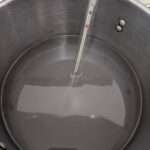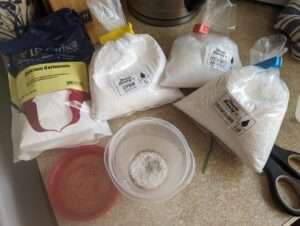Learning How to Condition Water for Homebrew
For the first two years of homebrewing I relied on the notion most every rookie home brewer starts with, “my tap water tastes fine, I will just use it”. It has served me well. Now that I have hit my stride, I decided to up my game, and see what I could do enhance the flavour profile of the malts, hops et al.
Where I Started
- Straight tap water on brew day, there was only a residual smell of chlorine, I didn’t feel it affected things.
- Plan ahead, tap water to the stock pot the night before, allow the chlorine to evaporate overnight.
- Filter the water through activated carbon, whether the night before, or on brew day. It does take about 10 minutes per 1.5 litres.
- Filter the water, then crush in 1/4 of a Campden tablet. This ensured any residual chlorine got dissipated.
- Right about now, keep reading.
Back to High School Chemistry

I did my own research, I found the City of Thunder Bay Water Report, albeit it was two years old, likely good enough for what I am doing. I took the numbers I could interpret and entered them into the online calculator at Brewer’s Friend, selected the desired target profile and then used the recommended additives to my strike water. It contained a generous amount of gypsum and epsom, it was cloudy. The wort at the end of the process tasted just fine.
Something just didn’t seem right about the cloudiness, so I talked to a friend who worked in the environmental field, specialising in water. I posed some questions about some of the key points from the report, fortunately he knew what I was talking about. He gave me some suggestions on how to further interpret the alkalinity, and it led me to do more research. Ongoing research, that is how science works. Who knew?
The Googles lead me to find the good people at Bru’n Water, what they offered from their website was a downloadable spreadsheet that allowed me to transcribe the values from the city water report, and at the other end if it, it gave me an approximate breakdown of the chemicals required to adjust the base water profile.
I am not the right person to provide a chemistry lesson, but what I learned from going back to the last time I studied chemistry, we need to adjust the values of calcium, magnesium, sodium, chloride, sulphate and bicarbonate.
Finally, My Conclusion
Based on my own research, and the numbers extrapolated, I am working with a base water profile of (all numbers in parts per million, or ppm) calcium 18, magnesium 11, sodium 3, chloride 1, sulphate (unable to ascertain) , bicarbonate 54.
Using a water chemistry calculator, I can find a target water style, and add things like gypsum, epsom, pickling/kosher (non-iodised) salt and baking soda in small amounts to adjust my water. Other additives are available, I will experiment with more later.




 To provide the best experiences, we use technologies like cookies to store and/or access device information. Consenting to these technologies will allow us to process data such as browsing behaviour or unique IDs on this site. Not consenting or withdrawing consent, may adversely affect certain features and functions.
To provide the best experiences, we use technologies like cookies to store and/or access device information. Consenting to these technologies will allow us to process data such as browsing behaviour or unique IDs on this site. Not consenting or withdrawing consent, may adversely affect certain features and functions.